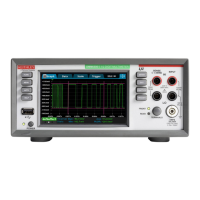In this section:
Introduction .............................................................................. 6-1
Equipment required .................................................................. 6-1
Device connections .................................................................. 6-2
Measuring 4-wire resistance with offset compensation ............ 6-3
Introduction
This application example demonstrates how to use the DMM6500 to accurately measure resistance.
Typical resistance measurements made using the 2-wire method source current through the test
leads and the device under test (DUT). The voltage is measured and the resistance is calculated.
It is difficult to obtain accurate 2-wire resistance measurements when the DUT is lower than 100 Ω.
Typical lead resistances lie in the range of 1 mΩ to 10 mΩ. When the 2-wire method is applied to low-
resistance measurements, there is a small but significant voltage drop across the resistance of each
test lead. The voltage measured by the instrument is not the same as the voltage directly across the
DUT.
The 4-wire method is preferred for low-resistance measurements. With this configuration, the test
current is sourced through the DUT using one set of test leads, while a second set of SENSE leads
measures the voltage across the DUT. Connect the voltage-sensing leads as close to the DUT as
possible to avoid including the resistance of the test leads in the measurement.
Thermoelectric voltages (EMFs) can seriously affect low-resistance measurement accuracy. The
DMM6500 can apply the offset-compensated ohms method (OCOMP), which makes one normal
resistance measurement and one using the lowest current source setting to eliminate EMFs.
For this example, you use a 20 Ω resistor. Fixed measurement ranges are applied in order to optimize
scanning speed and OCOMP is applied to correct for any EMF effects.
For comprehensive information on 4-wire resistance measurements, thermoelectric EMFs, and offset
compensation methods, see the Low Level Measurements Handbook, available on tek.com/keithley
.
Equipment required
• One DMM6500
• One computer set up for communication with the instrument
• Four insulated banana cables
• One device to be tested (the application shown uses a 20 Ω resistor)
Section 6
Measuring 4-wire resistance with offset compensation

